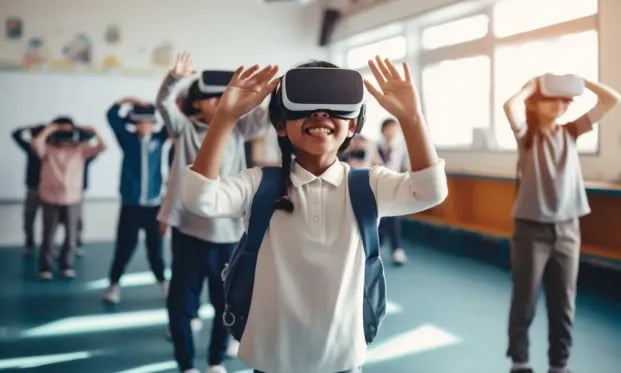The Role of Technology in Transforming Classroom
Technology is revolutionizing education in India, creating engaging and inclusive learning spaces. Smartboards, AI-driven platforms, and AR/VR tools enhance teaching, while cloud-based resources and hybrid models extend access. Efforts like DIKSHA and BharatNet bridge urban-rural gaps, and assistive tech fosters inclusivity. Despite challenges like infrastructure and costs, initiatives and training programs empower educators. By investing in tech, India prepares students for a dynamic future.
1/1/20253 min read


The Role of Technology in Transforming Classroom Environments in India
Technology has become a cornerstone of modern education, revolutionizing the way students learn and teachers instruct. In India, where educational needs are vast and diverse, the integration of technology into classrooms has opened new horizons. From urban centers to rural areas, technology is bridging gaps and creating inclusive, engaging, and effective learning environments. Here’s how technology is transforming classrooms across the country.
1. Digital Tools Enhancing Teaching and Learning
From interactive whiteboards to cloud-based platforms, digital tools are reshaping how education is delivered. Smartboards enable teachers to present lessons visually, making complex concepts easier to understand. Online learning platforms are extending classroom boundaries, allowing students to learn at their own pace.
Indian Context:
Schools like Amity International in Noida use smartboards and digital labs, while coaching centers in Kota integrate online mock tests into their curriculum, enhancing competitive exam preparation.
2. Personalized Learning with AI
Artificial Intelligence (AI) is enabling personalized learning experiences tailored to individual student needs. AI-driven platforms analyze student performance, identify areas of improvement, and recommend resources for better understanding. This ensures no student is left behind.
Indian Example:
Ed-tech platforms use AI to create personalized study plans, helping students prepare effectively for exams like JEE and NEET.
3. Bridging Urban-Rural Educational Gaps
Technology is breaking geographical barriers in education. E-learning platforms and satellite-based education programs are reaching students in rural areas, where access to quality education was once a challenge. Government initiatives like DIKSHA and NGO-led programs are pivotal in this transformation.
Indian Example:
The Pratham Education Foundation uses mobile-based apps to provide interactive learning modules to students in remote villages.
4. Gamification of Education
Gamified learning leverages elements like points, badges, and leaderboards to make education engaging and fun. This method motivates students to participate actively and enhances their retention of concepts.
Indian Example:
Schools such as Delhi Public School integrate gamified quizzes and digital storytelling tools to teach subjects like math and science interactively.
5. Virtual and Augmented Reality in Classrooms
Virtual Reality (VR) and Augmented Reality (AR) are transforming traditional rote learning into immersive experiences. Students can now explore historical monuments, conduct virtual lab experiments, or understand biological processes through VR and AR applications.
Indian Example:
Chennai Public School employs VR modules to help students virtually tour ancient Indian sites and global landmarks, enriching their understanding of history and geography.
6. Real-Time Feedback and Assessment
Digital tools enable real-time assessments and feedback. Teachers can instantly identify knowledge gaps and address them promptly, ensuring continuous improvement.
Indian Example:
Institutions like FIITJEE use online platforms to conduct daily performance assessments, allowing students to track their progress consistently.
7. Inclusive Education with Assistive Technology
Technology is empowering students with disabilities to participate actively in mainstream education. Tools like screen readers, speech-to-text software, and adaptive learning devices are making classrooms inclusive.
Indian Example:
The Aditya Birla World Academy in Mumbai incorporates assistive technologies to support students with visual and hearing impairments.
8. Cloud-Based Learning and Resource Sharing
Cloud technology facilitates the sharing of resources and collaborative learning. Students and teachers can access a vast array of materials from anywhere, fostering a culture of continuous learning.
Indian Example:
The Kendriya Vidyalaya network leverages cloud-based platforms to share educational content across its numerous branches.
9. Hybrid Learning Models
Hybrid classrooms combine physical and digital learning, offering the flexibility to adapt to various circumstances. This approach has gained momentum, especially during and after the COVID-19 pandemic.
Indian Example:
Schools like The Shri Ram School have successfully implemented hybrid models, allowing students to attend classes physically or virtually based on their preferences.
10. Preparing Students for the Future
Technology equips students with essential skills for the future, such as coding, data analysis, and digital literacy. Early exposure to such tools prepares them for careers in a technology-driven world.
Indian Example:
Institutes focus on teaching coding to young learners, ensuring they are ready for the demands of the future workforce.
Challenges and Solutions
1. Infrastructure and Connectivity Issues
In many parts of India, especially rural areas, lack of internet connectivity and infrastructure can hinder technology integration.
Solution: Initiatives like BharatNet aim to provide high-speed internet in rural areas, enabling digital classrooms.
2. Teacher Training
Teachers often lack the necessary skills to utilize technology effectively in classrooms.
Solution: Training programs like CBSE’s ICT Workshops equip educators with the knowledge to integrate digital tools into their teaching.
3. Cost Concerns
The high cost of advanced technology can be a barrier for schools and institutes.
Solution: Subsidies, public-private partnerships, and open-source tools can help lower costs.
Conclusion
Technology is transforming the educational landscape in India, making learning more accessible, engaging, and inclusive. By embracing innovations like AI, VR, and cloud-based learning, schools and institutes can create environments that nurture creativity, critical thinking, and collaboration. While challenges persist, continuous efforts by educators, policymakers, and technology providers ensure that Indian classrooms are evolving to meet the demands of the 21st century. Investing in technology today means empowering the next generation to lead tomorrow.
Consultation
Management
info@classroombanao.com
98101 72399
@ Unit of Space and Fit Out Technologies
Quick links
Blogs
Store
© 2024. All rights reserved.
